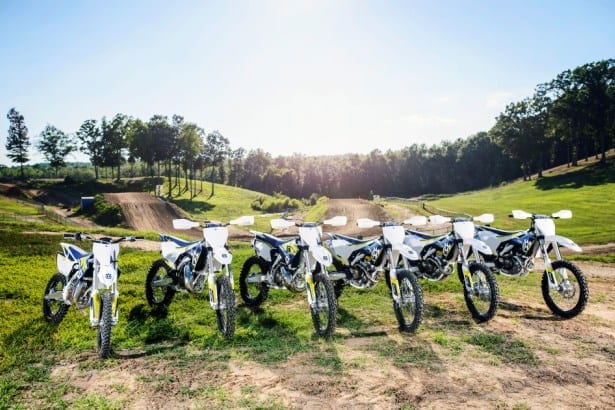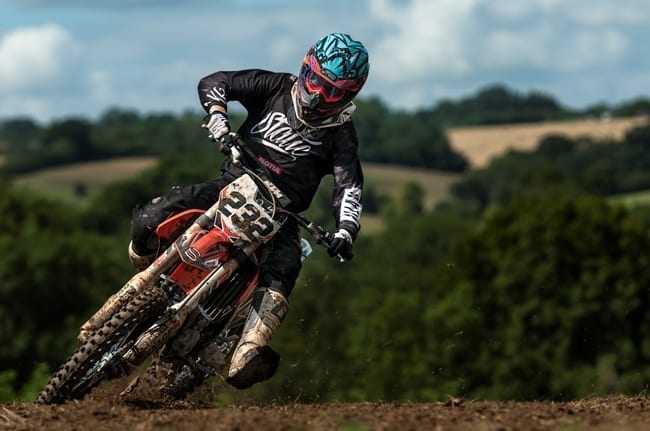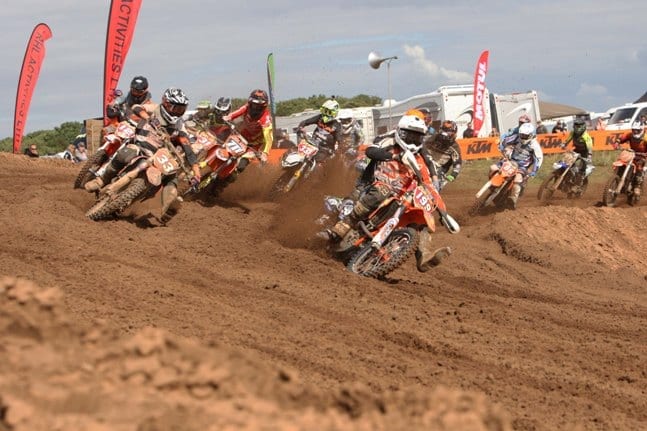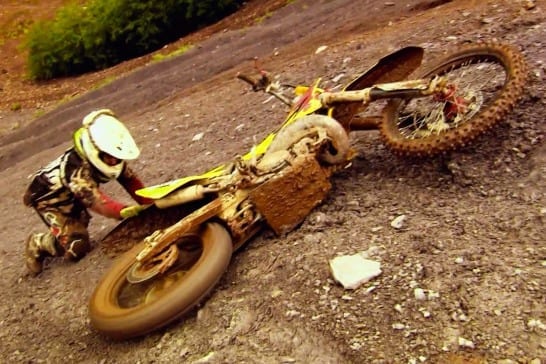ON TEST: Husky's earn their stripes
By TMX Archives on 19th Aug 15

Henry Hill loomed large before me as I opened the throttle, hooked it up a gear and began my very first ascent of the infamous climb. I crested this landmark of American motocross, tightened my grip and took a big ol gulp as the complete Budds Creek circuit was suddenly unveiled for my eyes to behold.
The track sprawled out beneath me as I hurled down the hill, it was at this point in that brief – albeit seemingly timeless – piece of airtime that the magnificence of the world famous circuit struck a chord. The stage was set for the 2016
Husqvarna Motocross launch... and what a stage it was.
It was in the land of the free and the home of the brave that Husqvarna chose to conduct its 2016 model launch – after all the USA has become Husqvarna's home away from home in recent years.
TMX was invited along to Washington DC, the epicentre of American power, to check out the new range and hear all about the immense
112-year history of Husqvarna – all while soaking in the staggering views of the White House and the Washington monument. After that, roughly an hour's drive down the highway – right through ‘redneck central' – the awesome Budds Creek circuit stood before us.
It was abundantly clear that Husqvarna staff were pumped to show off the company's brand spanking new 2016 range – and we here at TMX were just as excited to try them out.
Husqvarna Motorcycles most definitely have a wealth of the pioneering spirit, this has been the case throughout the company's 112-year history of uninterrupted design, development and production.
It's that spirit that pushed Husky to develop its new 2016 model range from the ground up.
The designers have focused on improving and developing key features over the entire range.
For example Husqvarna has been fixated on saving weight wherever possible – resulting in much lighter bikes across the board.
Comfort and rideabilty have also been a major focus point, with redesigned plastics and bodywork for improved seatgrip and better airflow. A new carbon fibre subframe reduces weight still further and also brings that weight closer to the centre of the bike for better handling.
Mass centralisation has been another focus in terms of the engine design. Husqvarna designers have reduced the size and weight of the engines through new compact designs and new shaft arrangements in order to increase performance and centralise that mass.
This is but a scratch on the surface of the multitude of changes and developments Husqvarna has made to its machinery.
However I think it's about time we get to the really important stuff, just how do these new machines perform on track – and what did we like best?
2016 TC125
Heading into the test the new TC125 offering was the bike that intrigued me most of all.
I currently run a 2015 TC125 as a long-term test bike for TMX's sister publication DBR, and I absolutely adore it.
We've made a few mods to it and bolted on a fair few bits and it's a specimen that I've grown to love and cherish.
So, naturally, I was very interested to see how the new model would fare against the old.
Immediately, on my very first lap around Budds Creek, I could feel just how much lighter the designers had made an already lightweight bike.
The new TC125 has lost more than 2kg in the engine alone, dropping from 92.3kg to 89.1kg overall.
These weight saving methods and focus on mass centralisation makes a bike that already felt like a BMX-er even easier to throw around and manoeuvre.
In terms of engine performance the new TC125 has been given a major boost and now pumps out a big 40hp.
That's a lot of ponies (two more than last year) for a little 125. This means that the power to weight ratio on this thing is pretty insane, particularly if you're a young lightweight kid making the jump up from an 85.
There were plenty of places to really open her up around Budds Creek and plenty of big ol' jumps to air her out.
There wasn't one jump on the track that couldn't physically be done on a 125, even if some of us were too scared to actually try them.
Even so every single jump on the track was achievable on this little 125... and we are talking about a fully-fledged AMA national track here, these aren't your typical Miss Daisy obstacles.
In a quick comparison to my 2015 version, I would say that the new model isn't quite so snappy off the bottom.
But this may be down to the variety of aftermarket bits and bobs that I have become accustomed to on my 2015 model TC125.
However the increase in horse-power most definitely gives the new bike a mid-range improvement.
In my opinion the 2016 TC125 may well be one of the strongest 125s out of the crate. It's got plenty of power – with some to spare – for any young kid making the move up into the adult ranks, while also being seriously lightweight and easy to manoeuvre.
And let's not forget just how much fun a little 125 action can be!
2016 FC250
with the 2016 model FC250 Husqvarna has again focused on reducing weight and improving handling and manoeuvrability.
The 250 was actually the very first bike that I got to spin laps on and considering that I'm usually a two-stroke rider and I hadn't quite yet got to grips with the enormous Budds Creek track I felt incredibly comfortable on board the FC250 incredibly quickly.
I think that speaks volumes as to just how well-designed this new model is as well as just how easy the 250 was to hop on and ride.
The entire 2016 range looks absolutely stunning, the futuristic-looking new body design that features more of the pearl blue colour with dashes of electric yellow really stands out from the crowd and in my opinion looks a lot fresher than the mainly white designs we saw last year.
But that's all a bit subjective really, it just depends on your personal taste... but you're wrong if you think the new range isn't damn well gorgeous!
However this new bodywork design hasn't just been done for looks alone.
Through this design the ergonomics of the bike have been completely revised to improve both control and comfort.
Additionally the new low-profile seat design with revised padding and a new high grip cover ensures optimal comfort and control no matter the track conditions.
All of this comes together on the track to create a seamless bond between bike and rider as you almost instantly feel at home aboard the 2016 FC250.
As already mentioned Husqvarna's primary goal for 2016 was weight reduction.
The FC250 has dropped an impressive 4kg, now sitting right on the brim of the 100kg mark overall.
As with the TC125, engine performance has been enhanced. The FC250 now pumps out 46hp, with a greater emphasis on increasing the torque.
You can really feel this on track. The power delivery out of the Budds Creek corners and up the iconic hills was absolutely beautiful – so smooth and responsive.
However the incredibly dry and humid conditions on the day did make the track rather tricky in places, particularly round the famous off-cambered turns.
Throttle control was key here and these sections proved to be rather difficult aboard the smaller capacity bikes. The 250 handled these turns a little better than the 125, but the best is yet to come in terms of manoeuvring these tricky turns.
As ever the 250 four-stroke field is a tough class but I think Husqvarna have out done themselves with the 2016 FC250. We may well have a race winning bike on our hands here.
2016 FC350
Prepare yourselves for a shocking new development... the 2016 TC 125 was not my favourite bike to ride around Budds Creek. Hard to believe I know. I've become a die-hard two-stroke advocate over the years and I never thought I'd be swayed otherwise. Yet the 2016 FC350 has done just that.
For the first time in my life I felt as though I could actually consider riding an MX1 bike full time.
That was the level of confidence that the FC350 inspired in me. I know, you can barely believe what you're reading, but these are the cold hard facts. I freaking loved the FC 350!
Compared to the smaller 125 and 250 I felt that the 350 suited the Budds Creek track far better. The long straights and huge jumps came a lot easier with the increase in overall power and top speed.
The slower, trickier, bone dry off-camber turns were also far more manageable on board the 350 with its awesome torque at the bottom end and silky smooth power delivery.
This 350 shares much of the same engine architecture with the smaller 250, meaning that the engine is small, compact, lightweight and centred.
It generates incredible handling and manoeuvrability while rivalling the 450 in terms of power output. The 350 puts out 58 ponies while only weighing 101.7kg – that's more than enough power for me (and most of us) while being a very manageable weight.
When riding the 350 it certainly doesn't feel as though you are ragging around the track on a big MX1 bike – that's a huge bonus in my eyes. Previously I've been an exclusive MX2 pilot (only having ridden MX1 machines occasionally for tests) and the thought of having to lug a big, heavy, powerful MX1 machine around the track never appealed to me.
Yet the combination of the lightweight feel, the useable power and the lifesaving – having to kick-start the big four bangers in the Budds Creek heat would've been a killer – electric-start come together to form the 2016 FC350, a bike I'm very seriously considering as a future steed of my own.
2016 FC450
Sixty-three horse-power. That is the incredible number that the beastly 2016 Husqvarna FC450 pumps out.
This is the most powerful motocross engine that Husqvarna has ever produced!
It may well be the strongest 450 engine out of the lot for 2016 – and it could all be yours.
However in my opinion it may just be a little too powerful for the average dude.
The problem with the 2016 FC450 is that it most definitely doesn't feel as though you're riding around the track on a big old fo-fiddy, which is a good thing really. The lightweight feel, the confidence-inspiring handling and the ease of manoeuvrability come together so nicely that it's easy to forget just how much power you have between your legs.
Essentially you're sitting on a damn rocket ship!
The big Budds Creek jumps proved no problem at all for the 450. In many cases I found myself landing way past the landing areas, which wasn't ideal. For me the 450 just had a little too much
SPECIFICATIONS
2016 model Husqvarna FC 250/ FC 350/ FC 450 (MX 4-stroke)
ENGINE
Motor type: Liquid cooled, single cylinder, 4-stroke
Displacement: 249.9 cc/ 349.7 cc/ 449.9 ccm
Bore x Stroke: 78 x 52.3 mm/ 88 x 57.5 mm/ 95 x 63.4 mm
Compression ratio: 14.4:1/ 14.0:1/ 12.6:1
Starter/ battery: Electric starter with Lithium Ion 12V 2.2Ah
Transmission: 5 gears
Fuel system: Keihin EFI, throttle body 44 mm
Control: 4-valve DOHC with finger followers (250 & 350)/ 4-valve SOHC with rocker levers (450)
Lubrication: Pressure lubrication with 2 oil pumps
Gears: 5 speed
Clutch: Wet multi-disc CSS-clutch, Magura hydraulics
Engine M/gement: Keihin EMS
CHASSIS
Frame: Central double-cradle-type 25CrMo4 steel
Subframe: Carbon fibre reinforced polyamide
Handlebar: Pro Taper, Aluminium Ø 28/ 22 mm
Front suspension: WP USD, 4CS, Ø 48 mm
Rear suspension: WP Monoshock with linkage
Travel front/ rear: 300/ 300 mm
Front/ rear brakes: Disc brake Ø 260/ 220 mm
Front/ rear tyres: 80/100-21”; 100/90-19”/ 80/100-21”; 110/90-19”/ 80/100-21”; 120/90-19”
Chain: 5/8 x 1/4”
Silencer: Aluminium
DIMENSIONS
Wheel base: 1,485 ± 10 mm
Ground clearance: 370 mm
Seat height: 960 mm
Tank capacity: 7 litres
Weight, no fuel: 100.1 kg/ 101.7 kg/ 102.4 kg
SPECIFICATIONS 2016 Husqvarna TC 125 & TC 250 (MX)
SPECIFICATIONS 2016 Husqvarna TC 125 & TC 250 (MX)
Engine type: Liquid cooled single cylinder, 2-stroke
Displacement: 124.8 cc/ 249 cc
Bore x Stroke: 54 x 54.5 mm/ 66.4 x 72 mm
Starter/ battery: Kickstarter
Transmission: 6 gears/ 5 gears
Fuel system: Keihin PWK 38S AG/ Keihin PWK 36S AG
Control: Exhaust control/ Exhaust control TVC
Lubrication: Mixture oil lubrication 1:40/ Mixture oil lubrication 1:60
Clutch: Wet multi-disc clutch, Magura hydraulics/ Wet multi-disc DDS-clutch, Brembo hydraulics
Engine Managgement: Kokusan
CHASSIS
Frame: Central double-cradle-type 25CrMo4 steel
Subframe: Carbon fibre reinforced polyamide/ Cross-linked polyamide
Handlebar: Pro Taper, Aluminium Ø 28/ 22 mm
SUSPENSION
Front: WP USD, 4CS, Ø 48 mm/ WP USD, 4CS, Ø 48 mm
Rear: WP Monoshock with linkage/ WP Monoshock with linkage
Travel front/ rear: 300/ 300 mm/ 300/ 317 mm
Front/ rear brakes: Disc brake Ø 260/220 mm/ Disc brake Ø 260/220 mm
Front/ rear tyres: 80/100-21”; 100/90-19”/ 80/100-21”; 110/90-19”
Chain: 5/8 x 1/4”
Silencer: Aluminium
DIMENSIONS
Wheel base: 1,485 ± 10 mm/ 1,495 ± 10 mm
Clearance: 375 mm/ 385 mm
Seat height: 960 mm/ 992 mm
Tank capacity: 7 litres/ 7.5 litres
Weight, no fuel: 89.1 kg/ 97.7 kg


